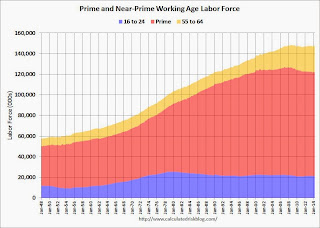by Calculated Risk on 6/29/2014 12:33:00 PM
Sunday, June 29, 2014
Demographics: Prime and Near-Prime Population and Labor Force
Earlier this week, I posted some demographic data for the U.S., see: Census Bureau: Largest 5-year Population Cohort is now the "20 to 24" Age Group and The Future is still Bright!
I pointed out that "even without the financial crisis we would have expected some slowdown in growth this decade (just based on demographics). The good news is that will change soon."
Here are a couple more graphs making this point. The first shows prime and near-prime working age population in the U.S. since 1948 (this is population, not labor force).
 Click on graph for larger image.
Click on graph for larger image.
There was a huge surge in the prime working age population in the '70s, '80s and '90s - and the prime age population has been mostly flat recently (even declined a little).
The near-prime group has been growing - especially the 55 to 64 age group.
The good news is the prime working age group will start growing again by 2020, and this should boost economic activity.
 The second graph shows prime and near-prime working age labor force in the U.S. since 1948 (this is labor force - the first graph was population).
The second graph shows prime and near-prime working age labor force in the U.S. since 1948 (this is labor force - the first graph was population).
The prime working age labor force grew even quicker than the population in the '70s and '80s due the increase in participation of women. In fact, the prime working age labor force was increasing 3%+ per year in the '80s!
So when compare economic growth to the '70s, '80, or 90's we have to remember this difference in demographics (the '60s saw solid economic growth as near-prime age groups increased).

As Bruegel notes, the working age population in the US is expected to grow over the next few decades - so the US has much better demographics than Europe, China or Japan (not included).
The key points are:
1) A slowdown in the US was expected this decade just based on demographics (the housing bust, financial crisis were piled on top of weak demographics).
2) The prime working age population in the US will start growing again soon.


